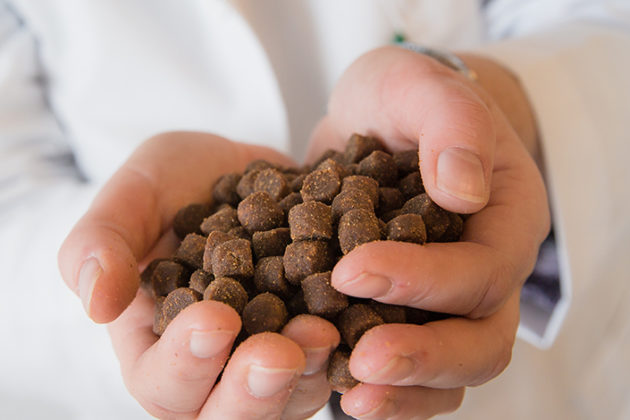An additive in feed technology with triple benefits

Scientists at Nofima have developed a process additive with triple benefits: it functions as a binding agent, has high nutritional value, and makes it easier to produce fish feed with good physical properties.
The additive can contribute to reducing the loss of feed in the aquaculture industry, and make the production of feed more energy-efficient. The process additive is a protein-based solution that can be manufactured from marine raw materials or plant proteins.
Approximately 1.5 million tonnes of feed are used for Norwegian farmed salmon every year. All of this feed is blown through long tubes into the fish cages, and it is extremely important, therefore, that the feed is manufactured to withstand the mechanical load it experiences. If this is not the case, the feed breaks up into small particles and dust, which the fish cannot eat, and the dust may also clog the feed-supply system. The loss in such feed delivery systems lies in the range 0.3-1.5%, which corresponds to an additional annual cost of between NOK 40 and 200 million. In order to reduce the loss, the feed must be homogeneous and have good physical properties.

PhD student Tor Andreas Samuelsen at the Nofima Feed Technology Centre in Bergen has studied how the loss can be reduced by measures taken during the feed processing. The principal goal of the project has been to divide fishmeal into its components, identify which of these influences the extruder, and determine their significance for the physical properties of the final fish feed.
Extrusion is a rapid kneading and cooking process that can be compared to baking bread in the kitchen at home. It is the most commonly used technology for the production of feed for salmon.
Proteins are crucial for quality
The physical properties of the fish feed can be controlled and improved by adding starch and other binding agents. However, the proteins in the feed also contribute to how well the pellets maintain their structure. An increasing amount of the proteins in commercial fish feed comes from the plant kingdom, and the fraction of proteins from marine raw materials is decreasing. This raises new challenges, and more knowledge about the technical properties of the ingredients used in fish feed manufacturing is required.
Samuelsen’s doctoral work has shown that positive properties are associated with water-soluble low-molecular-weight proteins in the fishmeal (small peptides and amino acids). Such proteins are pressed out together with water during the manufacture of fishmeal. The water that is pressed out is called stickwater, and has a positive nutritional value.
“We have shown how such proteins function during the manufacture of fish feed, and we have identified which type of proteins gives the desired effect. This means that we can use them better, not only to make the processing from raw material to pellet easier, but also as binding agent and nutritional component,” says Samuelsen.
Component functions
Fish feed is manufactured by mixing the ingredients in powder form, extruding the mixture with the addition of water and heat, and drying the pellets. Oil is then added and the product is packed. More water must be added when manufacturing feeds with high contents of vegetable proteins than those with high contents of fishmeal. This means that more water must be subsequently removed when the pellets are dried, which increases the energy consumption by approximately 30% compared with a traditional feed based on fishmeal. The process additive that Nofima has developed has several of the same properties as water. These water-soluble components with low molecular weights can, therefore, replace some of the water that is added during the process, and in this way reduce energy consumption.
The knowledge may also contribute to reducing the need for reprocessing of feed and give fewer complaints arising from poor physical properties of feed.
More knowledge about the properties of fishmeal
Several experiments at Nofima have shown that fishmeal is one of the most variable ingredients used in the production of feed. And Tor Andreas Samuelsen’s Ph.D. work documented the properties of fishmeal that makes it unique, and different from plant proteins, something that the industry has acknowledged. This knowledge can be used to improve the properties of plant proteins.
The research project has been carried out as a doctoral degree project in collaboration with the Department of Chemistry at the University of Bergen. Åge Oterhals (Nofima) has been principal supervisor, and Svein Are Mjøs (Department of Chemistry) co-supervisor. The project has been supported by the fishmeal industry in Norway and the Norwegian Seafood Research Fund (FHF).
Publications
Contact person
Research areas
Feed development and nutrition
Topics
Fish feed
